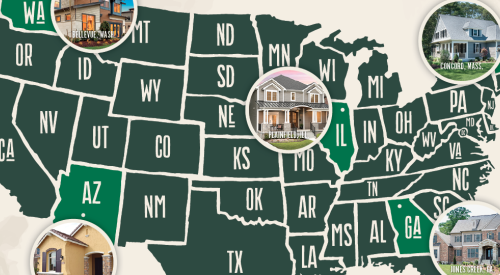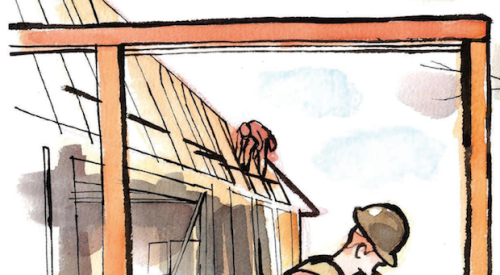Several factors determine the success or failure of expanding your operation into a new market or state. Location and product that appeal to potential buyers certainly make sense at the top of any list, closely followed by your ability to establish connections with real estate agents, landowners, lenders, and the local subcontractor base.
Among eight regional builders that recently expanded their reach within the past two years (scroll down to see sidebar), such moves and the motives behind them are as much (or perhaps more) instinctual as scientific, revealing insightful game plans for venturing into uncharted territories.
1] Hire people who know the terrain
Builders entering a new market often aren’t keenly aware of its nuances, so a safe route is to hire management talent with established reputations and connections—ideally in the new locale.
When California-based Williams Homes’ moved into Bozeman, Mont., for instance, it enlisted Chuck Beck, a 50-year veteran of that market, to be its construction manager.
Similarly, when Canadian home builder Empire Communities acquired Atlanta-based Edward Andrews Homes this past April, and with it 15 active communities in the Atlanta market and more than 85 employees, it retained founders Paul Edward Corley and Todd Andrew Hager to oversee that market for Empire.
Davidson Homes, with ambitions to close 1,000 homes in 2020 and to eventually be in every major metro in the Southeast, hired seasoned industry veterans Brad Nelson (previously with Lennar and M/I Homes) and Chris Smith (who had worked at Signature Homes and Goodall Homes) to run its new divisions in Raleigh, N.C., and in Nashville, Tenn., respectively.
“Our expansion plans have less to do with a set of cities and more to do with the people I meet in different cities who I think would be right to lead expansion there,” explains Adam Davidson, the company’s president and CEO.
In each new market, his company relies heavily on the operator, especially that person’s relationships with landowners, developers, and, in particular, real estate agents who deliver 70% of Davidson Homes’ buyers.
2] Think long-term from the start
“We hire divisional leadership that is already prepped to operate at a high level,” says Patrick Woods, COO for View Homes, which expanded into San Antonio in 2017 as Horizon Homes and added to that presence and expanded into Laredo, Texas, when it acquired Armadillo Homes earlier this year. “You can’t base your hiring needs on the size of the initial entry; it has to be based on the market projection size.”
When Goodall Homes expanded into Knoxville, Tenn., in 2017, it could build on 136 lots controlled by its parent company, Clayton Homes, based in the Knoxville area. But given that affiliation, as well as an attractive house design and streetscape and strong relationship with local trades, company president Bob Goodall Jr., saw a lot of potential for rapid growth.
The division, he says, also benefits from the youth and energy of its management team in that market—a team all under 30 years old “who have grown up in our culture,” says Goodall, and are hungry to see it grow in that image.
Two years later, Goodall Homes has expanded that portfolio to 301 finished lots in five communities and another 750 unfinished lots. The company expects to sell 147 homes and close 115 units in Knoxville this year.

3] Choose complementary markets
Andrew Guizzetti, EVP and CFO of Empire Communities, in Canada, says he prefers expanding into U.S. markets that have the same “complexity” as the company’s home base of Toronto—such as Houston.
A tip about land availability in that market and nearby Galveston from a hunting buddy who worked for a public builder there was the springboard for a major expansion that encompasses 2,000 developed lots acquired by the builder’s Continental Land division.
In Galveston, Empire now sells houses from two communities: Hidden Lakes, with 655 homes; and Coastal Point, with a total of 542 lots, 199 of which have been developed and are ready for future home construction.
In 2017, Empire opened a new division to build homes in Houston, where it has since built 1,145 homes in several communities and is planning to build another 3,281 units.
“What we like about Houston and Atlanta,” Guizzetti says, “is that both have good long-term growth prospects” and other factors familiar to the company’s structure and culture.
4] Stay close (enough)
Lance Williams, president and CEO of Williams Homes and a licensed pilot, has enabled his company’s expansion plans to markets he can fly to in his Cessna Citation CJ4 jet in under two hours from the builder’s base in Santa Clarita, Calif., hence its recent entries into Bozeman (900 air miles away) and Boise (674 air miles). “We want to stay engaged [in new markets] and don’t want time or distance to be a disincentive,” Williams says. Similarly, Bob Hawksley, CEO of Erlanger, Ky.-based The Fischer Group, cites “logistical range” as one of the company’s criteria for expansion.
Fischer’s 2018 acquisition of Dogwood Homes of Kentucky and its 940-lot land position in Louisville, for instance, meshed easily with the company’s “hub and spoke” operational structure, a central support system that encompasses and centralizes IT, product development, marketing, human resources, training, accounting and payroll, executive leadership, land development and acquisition support, estimating, architectural design and production, permitting, mortgage services, title services, corporate purchasing, and legal, allowing the divisions (“spokes”) to focus on their respective local issues and efforts.
“The system works well when product designs work in each market, and we can leverage support and administrative systems across the entire platform,” Hawksley explains.
5] Determine ‘must haves’
About five years ago, Williams Homes expanded into the Central Coast of California. That move proved successful, Williams says, and whetted his appetite for new growth opportunities outside of the Golden State ... as did visiting cities throughout the western U.S. with his kids to tour prospective colleges.
From those business and personal experiences, Williams developed a short list of “must-haves,” beyond proximity, for his company’s expansion strategy: university towns with outdoor lifestyle options and vibrant downtowns that appeal to both retiring Baby Boomers and household-forming Millennials; Bozeman and Boise checked all of the boxes. “We want to build where people want to live,” he says.

6] Seek job-friendly markets
Phoenix had been on Landsea Homes’ radar for a while, says Peter Beucke, the builder’s Arizona division president, and for one obvious reason: potential job growth.
The Newport Beach, Calif.-based builder, a U.S. division of Hong Kong-based Landsea Green Group, was specifically drawn to Chandler, Ariz., because of its job-friendly environment, namely tech giant Intel’s 10,000-plus employees base there and its plans to create another 7,000 jobs. It also didn’t hurt that Allstate Insurance plans to bring 2,500 jobs and a corporate campus to Chandler, as well.
Just 25 miles northwest, Phoenix added 86,800 jobs in 2018, a 4.2% gain that was the second-highest percentage for all metros, according to the U.S. Bureau of Labor Statistics. Beucke also notes, that 60,000 Californians relocated to Arizona last year.
7] Skirt where publics lurk
For the past several years, Alabama-based Truland Homes built up its core business in its home state so it could expand into adjacent markets along the Gulf Coast, specifically into what president and CEO Charles Schetter calls “midsize defensible markets” for his company.
The Florida Panhandle was a logical and attractive choice for Truland’s interstate growth, partly because it didn’t have as much big-builder competition as other metros in that state.
Today, the builder’s Gulf Coast markets are growing faster than similarly sized markets such as Raleigh-Durham and Charlotte, N.C., says Schetter, where publics are more prominent, and he expects the same in Pensacola, where Truland opened a division this past February.
8] Prepare to adjust product and pricing
Schetter says private regional companies like his “have to earn their right to be builders every day.” That starts with product and the extent that house plans may need to change as builders enter different markets.
Goodall, for example, notes that his company builds more homes with basements in Knoxville than in Nashville. The North Carolina towns of Holly Springs and Apex were the first markets where Davidson Homes built townhouses.
On its first 16-lot community in Bozeman, Mont., called Willson 16, Williams Homes is building three-story, 2,300-square-foot luxury duplexes with detached garages that will sell “north of $1 million,” says Williams, a departure from the detached product it builds in Southern California that sells in the $600s.
Houses that Truland Homes offers in all of its markets have similar features, such as extra-high ceilings, tall windows, and open floor plans. In Alabama, Schetter says the company has become very good at building a traditional house that sells for $400,000. But he also points out that half of the homes in the Southeast are valued under the FHA threshold of $315,000.
So while Truland’s product mix includes a beach home with no garage that’s priced in the $600s and $700s, the company also recently picked up scattered lots in Panama City, Fla., for its entry-level Aspire product, which sells from the $190s to the $220s.
Landsea Homes—which is active in Boston, New Jersey, and throughout California, where it builds a lot of three-story infill townhouses—has found that the Phoenix market “allows us to differentiate our product,” says Beucke, where many master planned communities offer 45-, 55-, and 65-foot lots that exceed most infill land plans.

9] ... Or not
Some builders strive for product uniformity, regardless of the market. Hawksley says that in Louisville, The Fischer Group immediately changed Dogwood Homes’ brand to Fischer Homes, and “Fischerized” three of Dogwood’s house plans.
The Fischer Group also negotiated a management fee contract with Dogwood’s owner and founder Richard Miles to build out his company’s remaining backlog, including those sold through its Landmark Custom Homes division.
When View Homes acquired Armadillo Homes, the latter’s price range, from $252,950 to $341,000, was notably higher than its acquirer’s. View Homes is now discontinuing Armadillo’s semi-custom Jeffrey Harrison Homes line, and “reworking” some of Armadillo’s other products to focus on first-time and first-time move-up buyers, COO Woods says.
10] Be conscious of brand
Beucke says that Landsea Homes pays a lot of attention to building science in its construction, and in Phoenix it will deliver “best-of-class, high-performance homes,” he says, a building and branding aspect Beucke honed from working with two solar power companies before coming to Landsea.
In Phoenix and other markets to which it has expanded, Landsea Homes operates under the same name, as does Davidson Homes when opening new divisions. But when expansion results from mergers and acquisition, there’s always some debate about which brand to favor: the already-established name or the new kid on the block.
All of View Homes’ brands in Colorado, New Mexico, and Texas are variations of the words “View” or “Horizon.” But because Armadillo Homes had such a great reputation in San Antonio, Woods says, its communities are being rebranded as Armadillo, a View Homes Company,” though he admits that could change in the future.
Similarly, Empire Communities plans to keep the Edward Andrews Homes brand in Atlanta, at least for the time being.
11] Measure results
During the last recession, View Homes was close to pulling out of southern New Mexico. But something told the builder to hang tough, and the bet paid off with about 100 sales per year since, Woods says.
The point is, expansion puts the future of these and other midsize, regional builders in flux, making it essential to establish metrics that set objective performance parameters.
View Homes’ goal when it entered San Antonio two years ago was to close 500 homes annually by 2020. That was an ambitious target, given that San Antonio is “very lot restricted,” Woods says. But his company’s acquisition of Armadillo Homes “jump-started” that projection, he adds.
The company isn’t standing pat in its existing markets, either: It’s testing an active-adult product in a 10-acre gated community in El Paso, Texas, and plans to bring an active-adult product to southern New Mexico next year.
Meanwhile, Davidson’s goal for any new market is to close 150 homes “as soon as possible,” at which point the market merits full staffing. (He thinks North Carolina could reach that point in 2020.) After that, he expects new markets to grow organically by 20% annually.
Truland Homes expects to close 500 homes per year, companywide, in 2020, and Schetter says he will measure the success of its Florida move by the time between the “first overhead burn” and the product’s grand opening, a schedule no longer than six months, he says.

The Builders
Davidson Homes
In 2018, this Huntsville, Ala.-based builder expanded into Middle Tennessee by purchasing nearly 350 lots in Lebanon, Gallatin, Murfreesboro, and Nashville, and later that year expanded into North Carolina, where it purchased around 140 lots in Holly Springs, Apex, Wake Forest, and Fuquay-Varina. Davidson Homes currently has three active communities in that state.
Empire Communities
In July 2018, this Toronto-based developer and builder, which already had a home building presence in Houston, acquired Centerra Homes, which had three communities in San Antonio and 11 in Austin. Empire expects to deliver around 400 homes in these three markets this year.
The Fischer Group
The Erlanger, Ky.-based builder is active in Cincinnati, northern Kentucky, southern Indiana, Indianapolis, Dayton and Columbus, Ohio, and Atlanta, and last year entered Louisville through its acquisition of Dogwood Homes of Kentucky, opening three new communities in that market last October. Fischer and Dogwood combined to deliver 285 homes in Louisville in 2018, a number that’s expected to increase to 325 this year.
Goodall Homes
In April 2016, Clayton Homes acquired Goodall Homes, the second-largest builder in Nashville, Tenn. Clayton already had lots on the ground in Knoxville and had contracted to develop more. A year later, it made sense for Goodall Homes to expand into that market—its first outside of Middle Tennessee—says president Bob Goodall Jr. The builder now has a team of 20 people in Knoxville, where it expects to close 150 homes in 2019.
Landsea Homes
In 2014, Nanjing, Hong Kong-based Landsea Green Group announced it would invest $1 billion in the U.S. housing market. Landsea Homes, based in Newport Beach, Calif., builds master planned communities in Northern and Southern California, Boston, and the New York metro area. In the summer of 2018, Landsea opened its Arizona division and acquired 78 lots in Chandler, Ariz., for a resort community called Sonora Crossing. In March of this year, Landsea acquired 90 single-family lots for a master planned community called Harvest Queen Creek in greater Phoenix, where land development is expected to begin in early 2020, with sales later that year.
Truland Homes
The Spanish Fort, Ala.-based builder expanded into Florida’s Panhandle by opening a western divisional office in Pensacola in the fourth quarter of 2018, and its eastern divisional office in Panama City in the first quarter of 2019. Truland Homes' Pensacola office’s first community, called Beachwood Estates, with 22 lots on 3 ½ acres in Santa Rosa Beach, Fla., is scheduled to open in June.
View Homes
This company, which recently changed its name from Desert View Homes, started in El Paso, Texas, two decades ago, expanded to southern New Mexico 15 years ago, and to Colorado Springs, Colo., where it’s currently based, in 2007. It expanded to San Antonio in 2017 as Horizon Homes, and last January acquired Armadillo Homes’ operations in San Antonio and Laredo, Texas. In 2018, Armadillo closed 543 homes in 20 communities.
Williams Homes
Based in Santa Clarita, Calif., the builder announced this spring that it was expanding its operations to Bozeman, Mont., where it has already done two land deals, one encompassing 16 lots on less than 2 acres (where rental properties and mobile homes once stood) for a townhouse community called Willson 16, and 42 finished lots of 5,000 square feet apiece for a community called Westwinds. Both are now under construction. Williams Homes also expanded into Boise, Idaho, where it purchased 19 finished infill lots, partnering with Hammett Homes, a local custom builder.
Access a PDF of this article in Professional Builder's July 2019 digital edition













